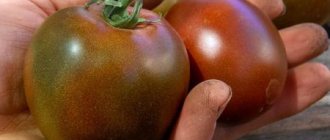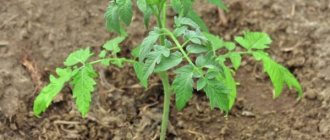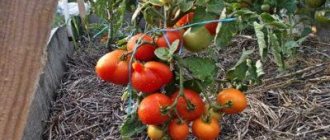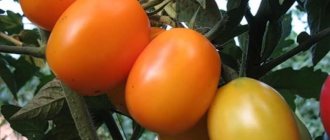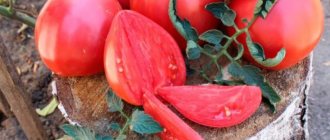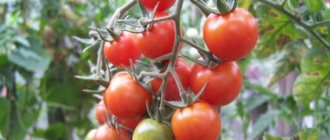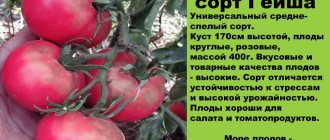Domestic breeders have been creative and will continue to be creative. Thanks to their authorship, the Striped Chocolate tomato appeared - incredibly beautiful and tasty. The rapid spread and popularity is evidence that the new product was a success.
| Height | Landing location | Ripening time | Fruit color | Fruit size | Origin | Fruit shape |
| Medium height | Greenhouse, Open ground | Mid-season | Bicolor | Large | Variety | Flat-round |
Description of the variety
Striped chocolate is a hybrid variety of tomato. It was bred by American breeders by crossing the Pink Beefsteak and Shimmage Craig varieties. This tomato has not yet been included in the Russian register.
Tomatoes of the Striped Chocolate variety are very unusual in appearance. They are large and have a pink or brown color with stripes (see photo).
This tomato belongs to determinate varieties. Its growth continues until a fruiting ovary appears at the top, after which the plant stops stretching. Typically healthy bushes of this variety reach 1.5 m in height.
The Striped Chocolate tomato variety has other names. The most common of them:
- Chocolate Striped;
- Chocolate strips;
- Chocolate Stripes.
Distinctive features
The main distinguishing feature of the variety is the unusual appearance of the fruit. Tomatoes are shaped like steak, they are large and flattened. Their color is brown or pink with dark stripes. The stripes can be chocolate, brown, olive, dark green, yellow or orange.
Striped Chocolate fruits are fleshy but juicy. They have a small number of seeds and a pronounced sweet taste. The skin of these tomatoes is thin.
Interesting! The variety is immune to most tomato diseases. It is even resistant to late blight, which most often causes crop damage.
These tomatoes are used for fresh consumption. Due to their thin skin and large size, they are not used entirely for preservation, but they are excellent for preparing tomato paste, ketchup, sauces, etc.
Characteristics
Tomato Striped chocolate, despite its exotic nature, is distinguished by its unpretentiousness and resistance to adverse environmental conditions. This makes it possible for even novice gardeners to cope with its cultivation.
Description of the characteristics of the variety:
| Parameter | Indicators |
| Bush type | Determinant. The average height of the bush is 1.5 m. Growth is completed after the formation of 6-8 clusters. It has powerful, weakly leafy stems. The leaves are wrinkled, dark green, and without pubescence. The root system is powerful. The first inflorescence is formed above the eighth leaf, the subsequent ones grow every second leaf. One inflorescence produces no more than five fruits |
| Growing method | Can be grown in protected and open ground. Unheated greenhouses are used |
| Productivity | Average. From 1 sq. m on average you can harvest 8 kg of tomatoes |
| Fruit | Brown or pink, the skin has stripes of green, yellow, orange or chocolate color. Inside there is an uneven brown and pink color, greenish soft veins may be present. The fruits are fleshy, but their dry matter content is low. Very large, on average one fruit weighs 600 g, but some can reach 1 kg. They have a thin, shiny, smooth skin. A tomato may contain up to eight small chambers and a minimal number of seeds. The fruits have a round, flattened shape and ribbing at the base. They have a bright tomato sweet taste with virtually no sourness. |
| Transportability | Low. They have a short shelf life. Thin skin will not allow transporting crops over long distances |
| Ripening time | Mid-season variety. From the appearance of the first shoots to ripening, 95-100 days pass |
| Disease resistance | Late blight, powdery mildew, crown and root rot, tobacco mosaic |
Important! The Striped Chocolate tomato is a young variety. Therefore, conclusions about the presence of immunity to the described diseases were made based on the experience of gardeners who grew it. Not enough research has been done to officially confirm this information.
Black and very sweet
Black tomatoes also have their own flavor
They are usually sweeter than red ones, and their color involuntarily attracts attention
The most famous variety is the Black Prince, the fruits of which are quite large, up to 200 g, and not completely black, but with a black tint. The fruits may not look very pleasant, but their taste is so good that almost all gardeners plant them with pleasure.
But if you want to plant real black tomatoes, then plant Black Pear or Creme Brulee. The bushes of these tomatoes are small - up to 100-150 cm. Black Pear has small fruits - only 50-80 g, and Creme Brulee has up to 200-400 g, flat in shape. When fully ripe, all of them acquire a rich brown color. These varieties are distinguished by a high content of vitamin C and carotene. And they are sweeter than regular tomatoes.
The Black Galaxy tomato variety is the brainchild of Seeds Technologies, a company specializing in the production of hybrid vegetables. Black Galaxy was obtained by crossing cultivated varieties with wild tomatoes. The peculiarity of the variety is that the longer the tomato is in the sun, the darker it becomes.
Growing seedlings
In order to get healthy and strong plants that will give a good harvest, in our country tomatoes are grown in seedlings. Seeds are sown in mid-March - early April.
Seed preparation
To speed up the germination of seeds and prevent them from becoming infected with diseases, you need to prepare planting material. Before doing this, make sure that the seeds have not expired.
To select seeds that can germinate, they are soaked in salt water for half an hour. The floating seeds are removed, and those that have settled to the bottom are washed and used for planting.
The seeds need to be disinfected. The most popular way is to soak them in a solution of potassium permanganate for 20 minutes.
Then the planting material is soaked for 12 hours in gauze moistened with warm water. You can use a growth stimulator - this will speed up the germination of tomatoes.
Since the sale of potassium permanganate without a prescription is prohibited, gardeners began to use another method, which involves soaking the seeds for a day in a soda solution. This method allows you to simultaneously disinfect and stimulate the growth of tomatoes.
Soil and container
Choosing the right soil is the key to successfully growing tomatoes.
Soil mixture options:
- Purchased mixtures. In the store you can buy soil mixtures intended for vegetables. They contain all the components necessary for plant growth.
- Prepare the soil yourself. This is the most economical way. The easiest way to prepare soil for tomatoes is to mix turf soil and humus in equal proportions. To make the soil more fertile, you can add sand and ash to the mixture.
- Peat tablets. This is the most convenient, but also the most expensive way to grow tomatoes. Such containers are bags that already contain peat soil with all the necessary fertilizers. When using this method, picking tomatoes is not required.
Purchased and homemade soil must be disinfected. This can be done by calcining it in the oven, pouring boiling water on it, or treating it with a solution of potassium permanganate.
You can take any containers for planting seeds: these can be special boxes, pots, cassettes or homemade containers.
Sowing planting material
The prepared and disinfected container is filled with soil mixture. Seeds are laid on it in rows. The distance between the rows should be 3 cm, and between the seeds - 1.5 cm. The seeds are sprinkled with soil mixture on top.
The container with the seeds is placed in a warm place until the first shoots appear. It needs to be covered with glass or film. If you maintain a temperature of 25 degrees, seedlings will appear a week after sowing the planting material.
The soil needs to be moistened regularly; it is best to do this with a spray bottle as it dries. If the soil becomes waterlogged, you need to remove the film and allow the excess moisture to evaporate.
Advice. Due to increased humidity, mold may appear on the top layer of soil. If this happens, then you need to carefully remove the contaminated layer of soil (without removing the seeds) and water the rest of the soil with a weak solution of potassium permanganate.
Rules for caring for seedlings
To get healthy and viable seedlings, you need to follow the following care rules:
- Provide plants with sufficient light. It is best to use a fluorescent or special phytolamp. If it is not there, then the boxes with seedlings should be placed in the brightest part of the room.
- Film or glass will create greenhouse conditions for the seedlings with a high level of humidity. Therefore, even after the first shoots appear, the structure is not immediately dismantled. First, the boxes are aired for several hours a day. After two weeks you can remove the glass.
- It is necessary to water fragile plants under the film so that water does not fall on their above-ground parts. For watering, you can use a syringe or pipette. Once you disassemble the greenhouse, you can start watering the tomatoes in the usual way. The water should be at room temperature. The soil is moistened as it dries.
- When the first true leaves appear, the plants are transplanted into individual pots. When replanting plants, a lump of earth should remain on their roots. One grown tomato needs at least 1 liter of soil. Therefore, gardeners often make two picks, each time using a larger container.
- Seedlings must be prepared in advance for transplanting into the ground. To do this, on warm and sunny days, plants are placed on the windowsill or taken outside. The first time the tomatoes are left in the fresh air for 15-20 minutes, then this time is increased to an hour or two. Gradually, you can begin to take the plants outside for the whole day.
- Seedlings are fed with organic fertilizers. For example, you can use vermicompost. For one plant, take half the indicated dose. The first fertilizing is done in the third week after plant germination. This is then done weekly.
Plant care
During the growing season, tomatoes of this variety must be periodically watered and loosened.
Watering
The amount of watering directly depends on weather conditions. In hot, dry weather, tomatoes are watered weekly. The soil must be wetted at least 40 cm.
Feeding
The application of mineral fertilizers is carried out in 2 stages:
- 10 days after planting in a permanent place, the tomatoes are fed with a solution of urea with potassium humate. Fertilizer application rates can be found on the packaging. It may vary depending on the manufacturer.
- The next feeding is carried out during the budding phase, using potassium monophosphate. If necessary, it can be replaced with other fertilizers of the phosphorus-potassium group: superphosphate, potassium sulfate.
During the growing season, in addition to mineral fertilizers, organic matter can be used. It is especially useful during the development of green mass and at the time of ovary formation. The following can be used as organic fertilizers:
- fermented mullein solution;
- bird droppings;
- fermented infusion of nettle.
The last option is the most accessible, since nettle is present in almost any garden or summer cottage. To prepare the fertilizer, nettles are tightly packed into a barrel or another suitable container. Fill the container to the top with water. When bubbles appear on the surface of the slurry, the fertilizer is ready for use. Before watering, the infusion is diluted in a ratio of 1:10.
Harvesting
Tomatoes are harvested in a slightly unripe state. When fully ripened, the tomato pulp becomes very soft. The fruits of the described variety are excellent for fresh consumption and preparation.
How to grow tomatoes
Growing the Striped Chocolate variety is not much different from caring for other tomatoes. It is unpretentious, and any gardener can cope with it. These tomatoes can be grown both in a greenhouse and in open ground. In the northern regions it is better to use the second option.
Transplanting
Before planting seedlings in a permanent place, you need to prepare the soil. Ideally, this is done in the fall.
For 1 sq. m of soil you need to take 0.5 kg of lime, 5 kg of organic fertilizers and 40 g of superphosphate. Dig the soil well before planting.
Advice. You should not grow tomatoes in one place for more than two years in a row. You cannot do this in beds where other nightshades (for example, potatoes or eggplants) grew last year. The best predecessors for this crop are legumes, onions, carrots and cabbage.
Before planting seedlings, you need to dig holes. The distance between rows should be 50 cm, and between plants - 40 cm. The holes are watered in advance.
Seedlings are placed in the prepared recesses. You need to remove it from the containers immediately before planting. The holes with plants are watered with water and filled with soil on top.
Before planting plants in their permanent place, it is worth disinfecting the soil. To do this, just pour it with a weak solution of potassium permanganate, prepared in a ratio of 1:100.
Plant care
Watering is done as the soil dries out. Usually it is enough to moisten the soil 1-2 times a week. The first time watering is carried out 10 days after planting the plants in a permanent place. Take 0.7 liters of water per well.
Hilling is done before watering. It is first done a week after planting tomatoes in the ground. Next, you need to hill up the tomatoes every 20 days.
The first feeding is carried out a week after planting. Organic fertilizers are used for it. The composition can be prepared by taking one part manure to eight parts water. 20 g of superphosphate is added to a bucket of this mixture.
After two weeks, the plants are fed again, but with mineral fertilizers. For 1 sq. m take 10 g of ammonium nitrate, 20 g of superphosphate, 15 g of potassium salt. After another 14 days, the tomatoes are fertilized with the same composition.
Striped chocolate needs garter. Otherwise, heavy fruits will break the bush.
The plant forms one, two or three stems. In the first case, the harvest will appear faster, and in the second and third it will be more abundant.
Pruning is done no more than once a week: all the shoots that appear under the brushes are broken off and the yellow leaves are removed.
Nuances of cultivation
There are several subtleties that not all novice gardeners know about. Taking them into account, you can avoid mistakes and get healthy and productive plants.
Tips for growing tomatoes:
- The most favorable time for watering is evening. On cloudy days, you can moisten the soil at any time.
- Mulching will help protect the plant from pests and diseases. As mulch, you can use straw, hay or special non-woven materials sold in stores.
- Water the plants only with settled water. It is important to pour the liquid only under the root, without touching the greens.
- Stepping should be done in the morning or evening. On the day of this procedure, the plants are not watered.
Diseases and pests
Reviews from gardeners indicate that the Striped Chocolate tomato is resistant to most diseases. He rarely even suffers from late blight, which is the most common cause of crop damage.
To protect the bushes from harmful insects, they can be sprayed with a soap solution. Regular weeding and loosening the soil will prevent damage to the bushes by mole crickets and slugs. Once a week, inspect the bushes and remove pests manually.
Attention! If the plants are covered in spots or their leaves are dry and curled, the problem may lie not in diseases, but in a lack of necessary substances. In this case, make sure that the fertilizing is applied correctly.
Landing
The seed boxes are treated with boiling water, a solution of potassium permanganate or soap. For disinfection purposes, the seeds are soaked in a red solution of potassium permanganate, and a growth stimulator is used to speed up germination. The earth mixture is prepared as follows: mix the soil from the site, peat and sand in equal parts. Or they buy a ready-made factory special mixture.
Seeds are sown at 2-3 seeds per square centimeter, covered with glass or film to maintain moisture. The container is placed in a warm place. When seedlings appear, the covering material is removed, placing the container in the brightest and sunniest place. In the phase of two true leaves, they pick into pots, watering the seedlings abundantly after planting.
Growing good seedlings
The first fertilizing of seedlings with nitrogen fertilizing is done 15 days after transplantation. At this time, they take care of young plants, loosening the root layer, carefully watering them, avoiding excess moisture. Monitor the heat and light conditions, highlighting the tomatoes if necessary. A couple of weeks before transplanting into the ground to a permanent place, young plants should be hardened off in the open air (for example, by taking the seedlings out onto the balcony during the day), gradually increasing the time spent.
Features of agricultural technology in open ground
Transplantation into the greenhouse is carried out in the first ten days of May, and they are planted on the street plot in late May-early June, when the threat of return spring frosts has passed. The soil should warm up to at least 15 degrees. The planting site should be well lit by the sun, but also have slight shading, for example from shrubs growing nearby, and be free from drafts.
Tomatoes are planted in the amount of 4 pieces per 1 square meter. m. The full cycle of care includes feeding with fertilizer, watering, loosening the soil under the bushes and weeding. Form tomato bushes into 2 stems as much as possible so as not to overload the plant.
Features of growing in a greenhouse and open ground
The Striped Chocolate tomato can be grown both in a greenhouse and in open ground.
There are differences in plant care for both methods. They begin already upon landing. If in a greenhouse only an earthen ball with plant roots is buried, then in open ground it is recommended to plant tomatoes in the ground on half the stem, removing excess leaves. This will help additional roots develop. The first few days after transplanting plants into open ground, they are covered with film at night.
Planting tomatoes in an unheated greenhouse can be done two weeks earlier than in open ground.
Characteristics of tomatoes Striped chocolate
From 10 to 16 kg of large and medium-sized fruits are collected per square meter of area. Fruiting in greenhouse conditions begins in June, in open ground - in July, and ends in mid-September. In some particularly warm areas, tomato growth can be observed until the end of the month.
Tomato yield is affected by:
- illumination of the landing site;
- fertilizer balance;
- regularity of feeding;
- sufficient soil moisture;
- timely loosening and weeding;
- soil fertility.
The plant is immune to viral diseases; only isolated cases of infection have been recorded. Pests don't like the taste of new tomatoes, so they prefer other varieties. In the description of the Striped Chocolate tomato, you can find a mention of late blight, but most often the plant resists it well.
Pros and cons of the variety
Tomato Striped Chocolate appealed to connoisseurs of original products. Ease of care and cultivation allowed the variety to become popular among ordinary gardeners. He was loved for other virtues:
- resistance to diseases and pests;
- long-term fruiting if agricultural practices are followed;
- original taste;
- unique aroma;
- high, stable yield;
- marketable condition;
- predominance of large fruits;
- beautiful colors.
As a disadvantage of Striped Chocolate, gardeners note that at elevated temperatures the fruits crack, which is why they then begin to rot. This also includes the need to tie the bushes to strong supports that do not always support the masses. The difficulty of transportation is also a disadvantage.
Collection and use of fruits
Striped Chocolate fruits ripen in mid-summer. Tomatoes can crack in hot weather, so they should be picked as soon as they are ripe.
From one bush you can collect 6-8 kg of fruit. All tomatoes of this variety are large, sometimes reaching 15 cm in diameter. The average weight of each fruit is 500-600 g. The weight of some specimens can reach 1 kg.
Tomatoes of the Striped Chocolate variety are mainly consumed fresh. They can be added to hot dishes or made into pureed preparations for the winter.
Garter and shaping
Immediately after planting, the tomato bushes are tied to stakes. You can also build trellises. This variety has no special formation features. Like most determinate tomatoes, it is grown with 1 or 2 stems:
- in the first case, the fruits grow larger,
- in the second, the size of the tomatoes is smaller, but the yield indicators increase.
In 1 stem
To form one stem on the plants, all lateral stepsons are removed. There is no need to wait for them to grow; plucking is carried out as soon as the stepsons reach a length of 3-4 cm. In total, 3-4 stepsons are carried out over the summer.
In 2 stems
When forming into 2 stems, 1 well-developed stepson is left on the bushes. In the future, it is necessary to remove all side shoots. The left stepson is tied to the trellis in the same way as the main stem.
Advantages and disadvantages of the variety
Benefits of Striped Chocolate:
- unusual fruit color;
- sweet pronounced taste;
- resistance to many diseases;
- large fruit;
- possibility of growing in protected and open ground;
- ease of care.
Among the disadvantages, it can be noted that the immunity of the hybrid has not been fully studied, and therefore has not been officially confirmed. Also on hot days the fruits may crack.
Diseases and pests of tomato crops
The variety is immune to late blight, mosaic and rot. But despite this, it is recommended to follow agricultural practices and carry out prevention. So, in the spring, the greenhouse is disinfected and its soil is replaced. In open growing conditions, crop rotation must be observed.
Fungal diseases on tomatoes
The risk of fungal diseases can be reduced by regular treatments with fungicidal compounds. They are applied at the root or used for spraying. To achieve results, such procedures are carried out once every 4 weeks, changing the drug each time.
It should be noted that this variety of tomatoes has high resistance to viral diseases, which practically do not affect Striped Chocolate bushes. Sometimes a variety can be damaged by late blight, but with regular preventive treatments of plants, they successfully resist this disease.
Pests practically do not attack bushes of this variety, since they do not like the taste of the Striped Chocolate tomato.
Characteristics of the Striped Chocolate tomato speak of it as a hybrid that is resistant to pests and the most common diseases.
According to reviews from gardeners, tomatoes are not susceptible to:
- powdery mildew;
- rot;
- late blight;
- mosaic.
Despite the high resistance to diseases, experts recommend preventive treatment of plants with complex antiparasitic drugs 1-2 times per season.
Compliance with the rules of agricultural technology allows you to achieve a high yield from the Striped Chocolate tomato variety.
The variety is resistant to many diseases:
- VTM,
- fusarium,
- Alternaria blight.
During a fungal epidemic, additional preventive measures may be required:
- ventilation of greenhouses through the upper transoms;
- irrigation with Bordeaux mixture;
- spraying with 1% Fitosporin.
Treatment of seeds with phytosporin before planting
Tomato varieties resistant to late blight for open ground
Pepper seedlings at home without picking
Treating seeds with hydrogen peroxide before sowing
Reviews about the hybrid
Feedback from farmers about Striped Chocolate is positive. Despite the fact that this variety has not yet been included in the Russian register, it is already popular.
Yaremenko Galina, Volgograd: “I grow a Striped Chocolate tomato in a greenhouse. I took it because of the unusual color. As it turned out, in addition to its interesting appearance, it also has a wonderful sweet taste with a pronounced tomato aroma.”
Sharikov Vladislav, Tula: “I really liked the striped chocolate. I was amazed not only by the color and taste, but also by the mass of fruits. Some tomatoes reached 800 g. I used only mineral and organic fertilizers and did not treat them against diseases.”
Care
This tomato variety, grown on site, does not require pinching. Careful gartering on strong supports is carried out as the plant grows. Fertilizers are alternated by preparing liquid solutions of organic and mineral complexes. In summer, you can do without nitrogen fertilizers.
Watering is carried out in the evening, abundantly at the root, 3 times a week, with water built up in the sun
The morning after watering, it is important to mulch the damp soil; this will help conserve moisture and be a good preventative against the appearance of earthen pests.
